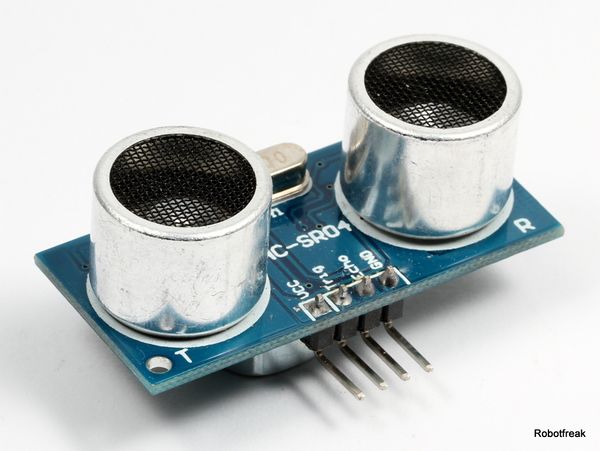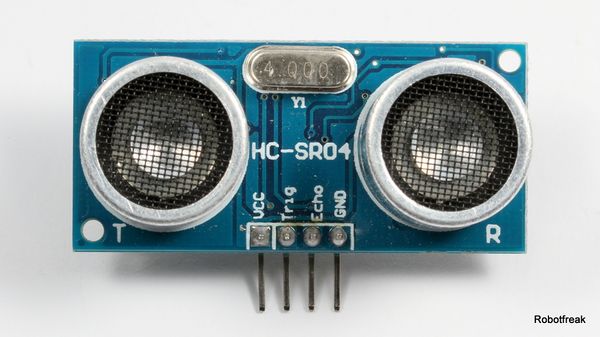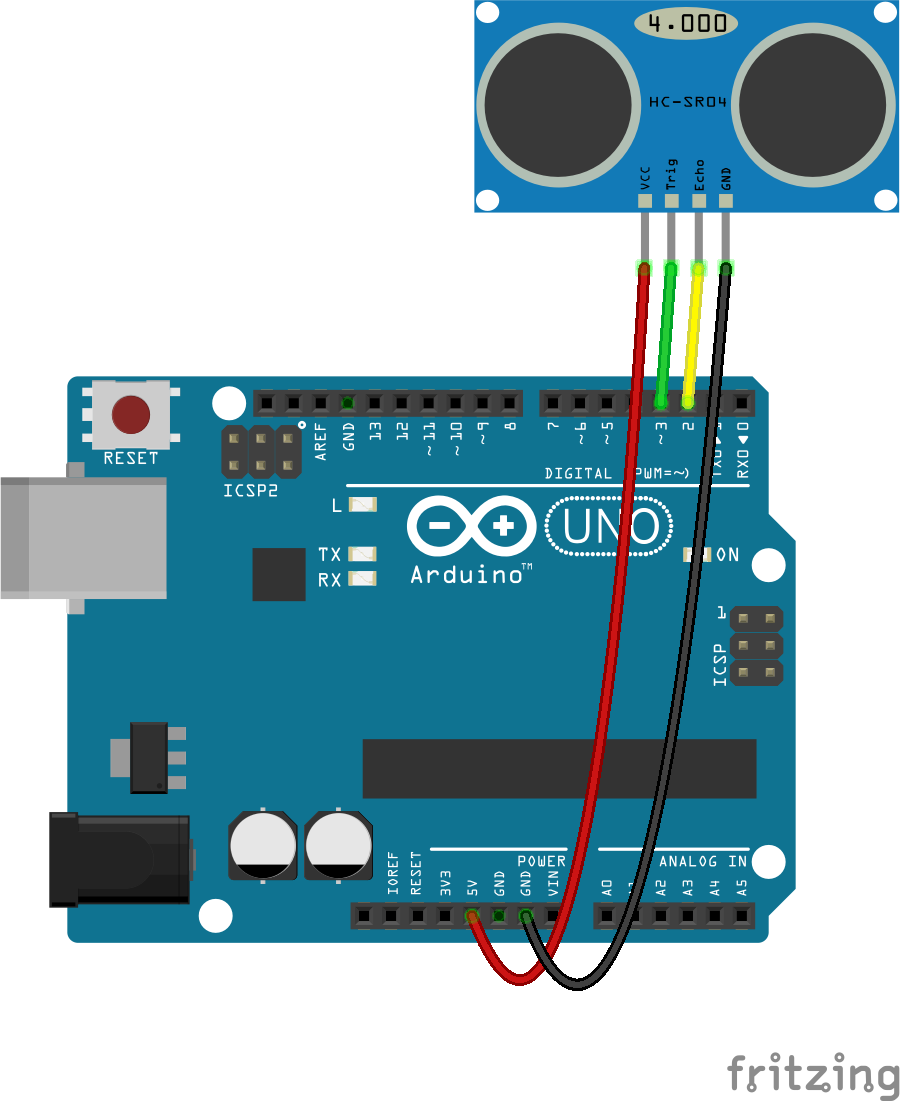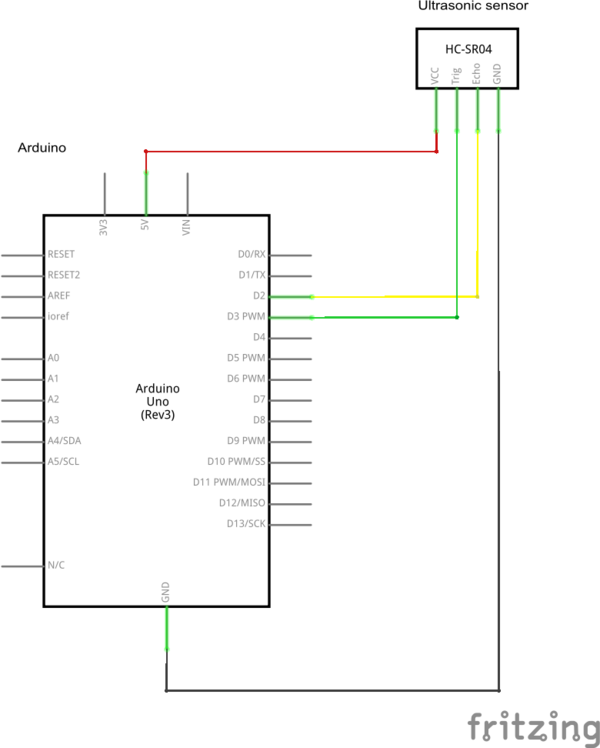HC-SR04: Unterschied zwischen den Versionen
(new file) |
K |
||
| Zeile 3: | Zeile 3: | ||
Der Ultraschallsensor HC-SR04 ist ein preiswerter Sensor um Entfernungen im Bereich 4cm bis 3m zu messen. Ideal für kleine Roboter zum Erkennen von Hindernissen. | Der Ultraschallsensor HC-SR04 ist ein preiswerter Sensor um Entfernungen im Bereich 4cm bis 3m zu messen. Ideal für kleine Roboter zum Erkennen von Hindernissen. | ||
| − | [[File:HC-SR04_side.jpg | + | [[File:HC-SR04_side.jpg|600px|alt=|HC-SR04]] |
== Wie funktioniert es? == | == Wie funktioniert es? == | ||
| Zeile 23: | Zeile 23: | ||
Pin 1: VCC Pin 2: Trigger Pin 3: Echo Pin 4: GND | Pin 1: VCC Pin 2: Trigger Pin 3: Echo Pin 4: GND | ||
| − | [[File:HC-SR04_front.jpg | + | [[File:HC-SR04_front.jpg|600px|alt=|HC-SR04]] |
== Anschluss an den Arduino == | == Anschluss an den Arduino == | ||
| Zeile 31: | Zeile 31: | ||
[[File:HC-SR04_wiring.png|frame|none|600px|alt=|caption HC-SR04 Verdrahtung]] | [[File:HC-SR04_wiring.png|frame|none|600px|alt=|caption HC-SR04 Verdrahtung]] | ||
| − | [[File:HC-SR04_schematic.png | + | [[File:HC-SR04_schematic.png|600px|alt=|HC-SR04 Schaltplan]] |
== Programm für den Arduino == | == Programm für den Arduino == | ||
| − | < | + | <syntaxhighlight lang="c"> |
| + | #define TRIGGER_PIN 3 | ||
#define ECHO_PIN 2 | #define ECHO_PIN 2 | ||
| Zeile 63: | Zeile 64: | ||
} | } | ||
| − | long microsecondsToInches(long microseconds) | + | long microsecondsToInches(long microseconds) |
{ | { | ||
// According to Parallax's datasheet for the PING))), there are | // According to Parallax's datasheet for the PING))), there are | ||
| Zeile 113: | Zeile 114: | ||
delay(50); | delay(50); | ||
} | } | ||
| − | </ | + | </syntaxhighlight> |
| + | |||
| + | [[Category:Elektronik]] | ||
| + | [[Category:Sensoren]] | ||
| + | [[Category:Arduino]] | ||
Version vom 17. Februar 2018, 23:49 Uhr
Inhaltsverzeichnis
HC-SR04
Der Ultraschallsensor HC-SR04 ist ein preiswerter Sensor um Entfernungen im Bereich 4cm bis 3m zu messen. Ideal für kleine Roboter zum Erkennen von Hindernissen.
Wie funktioniert es?
Im Prinzip wie beim Ortungssinn der Fledermäuse. Der Sensor sendet kurze Burst von Ultraschallwellen über den Ultraschall Sender aus, lauscht dann auf die empafngenen Echos und misst dabei die Zeit, sie zwischen Senden und Empfangen vergehen. Die Schallwellen legen ca. 343 m/s zurück. Die Formel zur Umechnung der Signal Laufzeit in die Entfernung zum Hindernis in cm ist:
Entfernung(cm) = Schallgeschwindigkeit (m/s) / Laufzeit (s) / 2 * 100
Es wird durch 2x die Laufzeit geteilt weil das Signal erst zum Hindenis hin und wieder zurückläuft.
Technische Daten
- Spannungsversorgung: 5V
- Stromaufnahme: 2mA
- max. Messrate: 50 Messungen pro Sekunde
Pinbelegung
Pin 1: VCC Pin 2: Trigger Pin 3: Echo Pin 4: GND
Anschluss an den Arduino
zum Anschluss an ein Arduino Board werden 2 Digital I/Os benötigt. EInen Trigger Ausgang, der den Sende Burst startet und einen Echo Eingang.
Programm für den Arduino
#define TRIGGER_PIN 3
#define ECHO_PIN 2
long duration;
long cmMsec, inMsec;
void initHCSR04()
{
pinMode(TRIGGER_PIN, OUTPUT);
pinMode(ECHO_PIN, INPUT);
digitalWrite(TRIGGER_PIN, LOW);
}
long readHCSR04()
{
long pulsein;
// The HC-SR04 is triggered by a HIGH pulse of 10 or more microseconds.
digitalWrite(TRIGGER_PIN, HIGH);
delayMicroseconds(10);
digitalWrite(TRIGGER_PIN, LOW);
// The same pin is used to read the signal from the HC-SR04 a HIGH
// pulse whose duration is the time (in microseconds) from the sending
// of the ping to the reception of its echo off of an object.
pulsein = pulseIn(ECHO_PIN, HIGH);
return pulsein;
}
long microsecondsToInches(long microseconds)
{
// According to Parallax's datasheet for the PING))), there are
// 73.746 microseconds per inch (i.e. sound travels at 1130 feet per
// second). This gives the distance travelled by the ping, outbound
// and return, so we divide by 2 to get the distance of the obstacle.
return microseconds / 74 / 2;
}
long microsecondsToCentimeters(long microseconds)
{
// The speed of sound is 340 m/s or 29 microseconds per centimeter.
// The ping travels out and back, so to find the distance of the
// object we take half of the distance travelled.
return microseconds / 29 / 2;
}
uint8_t EnPwmCmd[4]={0x44,0x02,0xbb,0x01}; // distance measure command
void PWM_Mode_Setup(){
pinMode(TRIGGER_PIN,OUTPUT); // A low pull on pin COMP/TRIG
digitalWrite(TRIGGER_PIN,HIGH); // Set to HIGH
pinMode(ECHO_PIN, INPUT); // Sending Enable PWM mode command
for(int i=0;i<4;i++){
Serial.write(EnPwmCmd[i]);
}
}
void setup(){ // Serial initialization
Serial.begin(9600); // Sets the baud rate to 9600
PWM_Mode_Setup();
initHCSR04();
}
void loop()
{
duration = readHCSR04();
cmMsec = microsecondsToCentimeters(duration);
inMsec = microsecondsToInches(duration);
Serial.print("CM: ");
Serial.print(cmMsec);
Serial.print(", IN: ");
Serial.println(inMsec);
delay(50);
}


